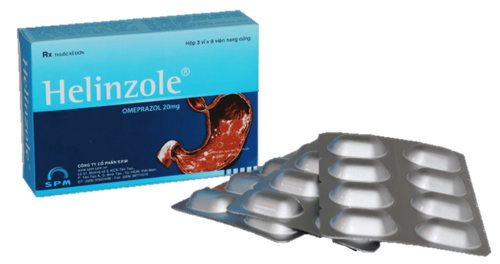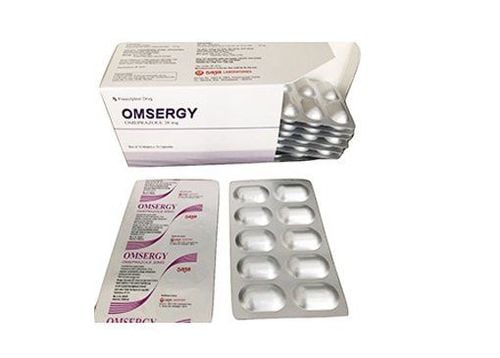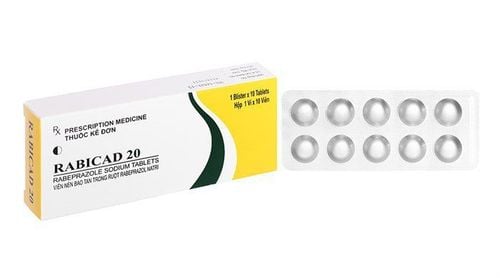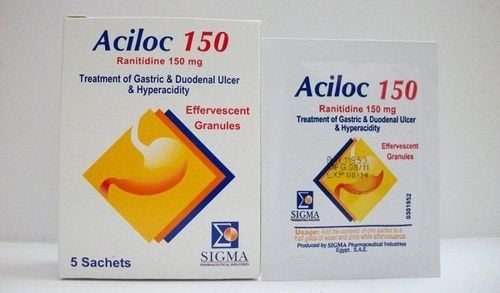This is an automatically translated article.
Vacoomez 20mg is an ETC drug used in the treatment of stomach ulcers, duodenal ulcers; gastroesophageal reflux; Zollinger-Ellison syndrome. What are the uses of Vacoomez s 20 to better understand? Indications of the drug Vacoomez s 20? What is the correct way to drink? What should be noted when using? The following article will help you better understand Vacoomez s 20.
1. What is Vacoomez s 20?
Vacoomez s 20 has the main ingredient Esomeprazol, which is made in the form of 20mg hard capsules, manufactured by Vacopharm pharmaceutical joint stock company.
Ingredients in 1 capsule Vacoomez s 20 include: Sugar, Sodium Carbonate, Lightly Oxidized Magnesium, Hydroxypropyl methylcellulose E5, Disodium hydrogen phosphate, Sodium lauryl sulfate, Crospovidon, Mannitol, Talc, Eudragit L-30 D, Sodium hydroxide, Diethyl phthalate, Tween 80, Titanium dioxide, PEG 6000.
Packing form: 1,3,5,10,50,100 blisters, 10 capsules each. Or the bottle has 28 or 100 tablets.
Vacoomez s 20 is prescribed by doctors in the following cases:
Benign gastric - duodenal ulcers. The Zollinger-Ellison Society. Patients with severe gastro-oesophageal reflux disease Prevent recurrence of peptic ulcer symptoms.
2. What are the uses of Vacoomez s 20?
2.1. Pharmacodynamics Esomeprazole is the isomer of omeprazole (S-isomer)
Esomeprazole is a proton pump inhibitor that inhibits gastric acid secretion by specifically inhibiting H+/K+-ATPase in gastric parietal cells. The S-isomer of omeprazole is protonated and metabolized in the acid compartment of the cell to form the active inhibitor, achiral sulphenamide. By acting specifically on the proton pump, esomeprazole blocks the final step in acid production, thereby reducing acid levels in the stomach. Therefore, Esomeprazole has an inhibitory effect on gastric acid secretion and also when activated by any agent.
2.2. Pharmacokinetics * Absorption
Esomeprazole is rapidly absorbed after oral administration, peak plasma concentrations after 1-2 hours. The effect of esomeprazole increased with dose and, when repeated, reached approximately 68% with 20 mg and 89% with 40 mg for the same time period. Taking with food slows and reduces the absorption of esomeprazole.
* Distribution
Esomeprazole is 97% bound to plasma proteins. Binding to plasma proteins is constant over a concentration range of 2 to 20 μmol/L. The apparent volume of distribution at steady state in healthy volunteers is approximately 16 L.
* Metabolism
Esomeprazole It is extensively metabolized in the liver by the cytochrome P450 (CYP) enzyme system. The metabolites of esomeprazole have no antisecretory activity. The major part of esomeprazole metabolism is dependent on the isoenzyme CYP2C19, which forms hydroxy and desmethyl metabolites. The remainder depends on CYP3A4 forming the sulphone metabolite.
* Excretion
The plasma half-life of esomeprazole is about 1 to 1.5 hours. Less than 1% of the parent drug is excreted in the urine. Approximately 80% of an oral dose of esomeprazole is excreted as inactive metabolites in the urine, and the remainder is found as inactive metabolites in the faeces.
2.3. Contraindications Patients who are allergic to any of the ingredients or excipients listed above of the drug Vacoomez s 20 Special target groups are children under 18 years old, pregnant and lactating women. 2.4. Drug side effects Common side effects may include:
Headache Diarrhea; Nausea, stomach pain, flatulence, constipation; or Dry mouth. Taking esomeprazole long-term can cause you to develop tumors in your stomach called adenomas.
If you use esomeprazole for longer than 3 years, you may have a vitamin B-12 deficiency.
Notify your doctor right away if you have:
Severe abdominal pain, watery or bloody diarrhea; Convulsions Kidney problems--fever, rash, nausea, loss of appetite, joint pain, urinating less than usual, blood in your urine, weight gain; low magnesium--dizziness, fast or irregular heartbeat, shaking (shaking) or jerking muscle movements, restless feeling, muscle cramps, muscle spasms in your hands and feet, cough or stuffy feeling breathe; or New or worsening symptoms of lupus - joint pain and a skin rash on your cheeks or arms that worsen in the presence of sunlight. 2.5. Drug Interactions Tell your doctor about all your current medications. Many drugs can affect Vacoomez s 20, especially:
Cilostazol; Clopidogrel; Diazepam ; Digoxin; Erlotinib; Iron-containing medicines (ferrous fumarate, ferrous gluconate, ferrous sulfate, and others); Methotrexate; Mycophenolate mofetil; Rifampin; Tacrolimus; Warfarin (Coumadin, Jantoven); antifungal medicine - itraconazole; ketoconazole, or HIV/AIDS medicine--nelfinavir, atazanavir, saquinavir. 2.6. Precautions for use In adults, symptomatic response to treatment with esomeprazole magnesium does not exclude the presence of gastric malignancy. Consider further monitoring and diagnostic testing in adult patients with suboptimal response or early symptom recurrence after completion of proton pump inhibitor (PPI) therapy. In elderly patients, endoscopy should also be considered. Acute interstitial nephritis has been observed in patients taking PPIs including magnesium esomeprazole. Acute interstitial nephritis can occur at any time during PPI therapy and is commonly attributed to an idiopathic hypersensitivity reaction. Discontinue esomeprazole magnesium for acute interstitial nephritis Published observational studies suggest that PPI therapy such as esomeprazole magnesium may increase the risk of Clostridium difficile diarrhea, particularly in hospitalized patients. This diagnosis should be considered for diarrhea that does not improve. Skin lupus erythematosus (CLE) and systemic lupus erythematosus (SLE) have been reported in patients taking PPIs, including esomeprazole. These events occur as both new onset and exacerbation of existing autoimmune disease. The majority of cases of lupus erythematosus caused by PPIs are CLE. Avoid concomitant use of esomeprazole magnesium with clopidogrel. Clopidogrel is a prodrug. Clopidogrel's inhibition of platelet aggregation is entirely due to an active metabolite. The metabolism of clopidogrel to its active metabolite may be impaired when used with concomitant drugs, such as esomeprazole, that inhibit CYP2C19 activity. Daily treatment with any acid-suppressing drug for long periods of time (eg, more than 3 years) can lead to malabsorption of cyanocobalamin (vitamin B-12) due to decreased or achlorhydria. Hypokalemia, symptomatic and asymptomatic, has been reported rarely in patients treated with PPIs for at least three months, in most cases after one year of treatment. Serious side effects include tetanus, arrhythmias, and seizures. In most patients, treatment of hypokalemia requires replacement of magnesium and discontinuation of PPIs.
3. How to use Vacoomez 20mg effectively?
3.1. Dosage The tablets should be swallowed whole and should not be crushed or chewed.
3.2. Dosage for symptomatic relief of acid indigestion:
10 or 20 mg/day for 2-4 weeks.
Treatment of gastroesophageal reflux syndrome (GERD):
+ Usual dose: 20 mg x 1 time / day for 4 weeks, an additional 4-8 weeks if not completely cured. In cases of persistent esophagitis, a dose of 40 mg/day may be used.
+ Maintenance dose after healing of esophagitis is 20 mg x 1 time / day and for acid reflux is 10 mg / day.
Treatment of peptic ulcers:
+ Single dose: 20 mg/day, or 40mg/day in severe cases. Continue treatment for 4 weeks for duodenal ulcers and 8 weeks for gastric ulcers. Maintenance dose: 10-20 mg x 1 time/day.
For eradication of Helicobacter pylori in peptic ulcers: Omeprazole can be combined with other antibiotics in dual or triple therapy:
Dual therapy: Vacoomez s 20 mg twice daily for 2 weeks.
Triple therapy: Vacoomez s 20 mg x 2 times/day for 1 week.
Treatment of gastric ulcers caused by non-steroidal anti-inflammatory drugs:
20 mg/day; A dose of 20 mg/day is also used for prevention in patients with a history of gastrointestinal injury requiring continued non-steroidal anti-inflammatory drug therapy.
Zollinger-Ellison syndrome:
60 mg once daily, adjusted as needed. Most patients are effectively controlled at doses ranging from 20 to 120 mg/day, but doses up to 120 mg 3 times/day can be used. Doses above 80 mg per day should be divided into 2 doses. Prevention of acid aspiration during general anesthesia:
40 mg the evening before surgery and an additional 40 mg 2-6 hours before the procedure.
Please dial HOTLINE for more information or register for an appointment HERE. Download MyVinmec app to make appointments faster and to manage your bookings easily.













